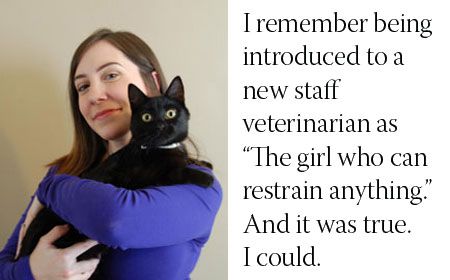When your job becomes a chronic pain
Years of heavy lifting and repetitive motions as a veterinary technician took a toll on my body. Im sharing my story story to prevent others from sharing my pain.

As a barely 18-year-old kennel worker in my first veterinary job, I was anxious to prove my worth and dedication to the field. Little did I know, 10 years later I would regret solo wrestling matches with dogs almost my same size. When I was younger and stronger I had an “I can do it alone!” mentality. Unfortunately, rather than correct me, my superiors and coworkers applauded me, which only made me push myself further.
I remember being introduced to a new staff veterinarian as “the girl who can restrain anything.” And it was true. I could.
Though she be but little, she is fierce
I'm five feet tall on a good day and at that time only weighed 105 pounds, but handle a 120-pound rottweiler? No big deal. I could do it by myself. Lift that 75-pound Labrador onto the exam table? Got it.
I continued this behavior for many years, and I've witnessed it in others many times throughout my career. And it's not just the newbies-seasoned pros are forcing their bodies beyond their limits to get the job done. There are a few reasons this happens.
1. The desire to prove one's worth.
2. Understaffing. I've worked many times as the lead technician with only one assistant to restrain for me. When you work in a clinic with only two to five team members and someone calls in sick, you're basically screwed for the day. You can't just cancel all of the appointments because a hyper Rhodesian ridgeback is scheduled for a nail trim. The team adjusts and picks up the slack.
Understaffing isn't always due to an employee with the flu, though. Many clinics operate on a small budget, and to cut overhead costs they employ fewer people to do more jobs.
3. The failure to use chemical restraint methods when needed. I've heard many times, “Let's just try to get it done quickly” or “It's just a nail trim.” But when you need four team members to lay on top of a dog just to accomplish a simple task, it's not only a problem for the dog's well-being, but an issue for your team members' physical well-being. After all these years, I've learned to dial it back and know my own physical limits. But I learned the hard way.
The consequences
At the tender age of 25, I was diagnosed with chronic myofascial pain syndrome (CMPS). This is a fancy way of saying I have chronic muscle pain caused my overuse, misuse and damage of muscle tissue. This condition manifests in fibrous knots in your muscles, also known as trigger points.
"Now, at only 29 years old, I'm back in college to explore other career options-not because I don't love what I do, but because I can't physically continue doing it. CMPS affects my day-to-day life as well. I'm also the mother of a toddler, and after a day of lifting her in and out of the car, my body is screaming."
My symptoms are isolated to my neck and shoulders. Repetitive motions are a major factor in the muscle abuse. I can't help but think that a combination of restraint techniques, heavy lifting and hunching over a dental table while scaling teeth are the primary causes of my muscle pain.
At the time I was diagnosed with CMPS, I worked for a veterinarian who kept us understaffed and despised chemical restraint. There were many occasions that I was the only technician doing 20 or more dental cleanings in a month. I dreaded pet dental health month because it meant a constantly throbbing right arm and shoulder.
I wish I'd known better before it became a chronic issue for me. Now I truly pay for it.
Now, at only 29 years old, I'm back in college to explore other career options-not because I don't love what I do, but because I can't physically continue doing it. CMPS affects my day-to-day life as well. I'm also the mother of a toddler, and after a day of lifting her in and out of the car, my body is screaming.
Be your own advocate
Working with other women who've had similar symptoms, I often wonder if they've done to their bodies what I've done to mine. As a profession, there must be more education and enforcement of proper restraint and lifting techniques. Enforcement is really the key. Managers and doctors must take responsibility for enforcing policies that promote safety.
Perhaps even more important is being an advocate for yourself. Learn when to say no and when too much is too much. I write this as a warning to those who've behaved just like me. Ask for help. Tell your veterinarian if you believe you need chemical restraint. No one will doubt your skills or dedication and your body will thank you in the long run.
Abigail Fishaw, LVT, resides in Norfolk, Virginia, with her husband, daughters and pets. She's worked in the veterinary field for 11 years and has been a licensed veterinary technician since 2009. Abby has a special affinity for black and white cats and Cavalier King Charles spaniels.